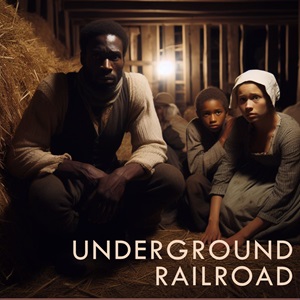


People involved with the story of Pennsylvania's Underground Railroad network, including activists, freedom seekers, station masters, conductors, financiers, lawyers, slave hunters, abolitionists, anti-slavery and pro-slavery adherents, politicians, heroes, villains and more.
Study Areas
Who's Who in Pennsylvania's Underground Railroad
C Surnames
- Cain, Ermine
- Location: Waynesburg, Greene County ; Role: African American UGRR stationmaster, conductor
Documentation: Boyd Crumrine, History of Washington County, 1882; Earle Robert Forrest, History of Washington County, Pennsylvania, 1926, p. 426.
While working as a barber in Waynesburg, Greene County, Ermine Cain also supervised the movement of fugitive slaves through his area to the next station, which was west to Rogersville, Center Township. Cain reputedly sheltered and fed fugitives at a nearby spring in a dense thicket before hiding them in a lumber drying house. He would then send them to Rogersville. From Rogersville, the freedom seekers were sent on a more northerly route to West Alexander, in Washington County, then to West Middletown (seeAsbury, William, and McKeever, Matthew). At that point, some accounts have fugitives from Cain's station being taken to Samuel Dorsey in Washington.
- Calder, Dr. James
- Location: Harrisburg, Dauphin County ; Role: UGRR stationmaster
Documentation: "Death of an Eminent Divine," Harrisburg Daily Independent, 23 November 1893; A. B. H., "Short Stories of Harrisburg," Harrisburg Telegraph, 20 September 1940; Ken Frew, Building Harrisburg, Historical Society of Dauphin County and Historic Harrisburg Association, New Cumberland, PA, 2009, p. 33, 35, 46.
His 1893 obituary states that Dr. Calder "was prominently identified with the underground railway for the purpose of liberating slaves during and long before the civil war. He was a great friend of the negroes and very much opposed to slavery." He lived on the family farm at Eighteenth and Walnut Streets in Harrisburg, at the edge of present day Reservoir Park. A 1940 news article about Harrisburg Underground Railroad operations includes the note "The Calder Farm at Eighteenth Street was one of the stations."
During the Confederate invasion of Pennsylvania in June 1863, African American refugees from the Cumberland Valley poured into Harrisburg and sought refuge in the rows of houses in Springdale, between Fifteenth and Eighteenth Streets next to present day Reservoir Park and on a portion of the Calder farm. Many of these refugees stayed and what was a temporary war refuge eventually developed into a vibrant African American neighborhood.
Dr. Calder graduated from Wesleyan University and married the daughter of noted local abolitionist Rev. John Winebrenner. Calder for several years edited the Church Advocate newspaper, which was noted for publishing anti-slavery articles. His close association, financial support and advocacy on behalf of Harrisburg's Black residents led to the official naming of the 1861 "Colored School" at the corner of Calder and Marion Streets in Verbeketown, which he financed, to the Calder School, in his honor. His financial support is also associated with the c1860 African American Springdale School, built in the 1800 block of Jonestown Road. The Springdale School ceased to be a Black school when ownership was obtained by the Harrisburg School District in 1869. - Carmalt, Caleb
- Location: Friendsville, Susquehanna County ; Role: UGRR stationmaster
Documentation: Edward H. Magill, When Men Were Sold, Reminiscences of the Underground Railroad in Bucks County and Its Managers, in A Collection of Papers Read Before the Bucks County Historical Society 2(1909): 493-520.
- Carmalt, Isaac P.
- Location: Clayville (Punxutawney), Jefferson County ; Role: UGRR
stationmaster, conductor
Documentation: W. J. McKnight, MD, A Pioneer Outline History of Northwestern Pennsylvania, 1905.
Isaac P. and Hannah Carmalt's Clayville station received fugitives from Centre and Clearfield Counties, according to his daughter. The route was fron "Centre County, near Bellefonte, kept by a friend by the name of Iddings, who sent them to the next station, which was Grampian Hills, from thence to our house." He led freedom seekers to Christopher Fogle in Brookville, near the center of the county. Carmalt was threatened for his activities by some neighbors who were sympathetic to pro-slavery powers.
- Carter, Joah (James)
Carter, Elizabeth - Location: Freehold Township; Sugar Grove Township, Warren County ; Role: UGRR
stationmaster
Documentation: Gregory Wilson/Warren County Historical Society, "Underground Railroad Sites in Warren County, PA," 2005, http://www.paundergroundrailroad.com/sites.htm, accessed January 6, 2006.
English-born Joah Carter received fugitives from Corry, Erie County, and Tidioute and hid them on his property until it was safe to send them onward. His home was located between Sugar Grove and Lottsville. He is shown on the 1850 census as a 64-year-old farmer, living with Elizabeth, age 61, also born in England, Joseph, age 21 and Joshua, age 19. Both boys were born in New York.
- Chadwick, Elihu
- Location: Rockland Township, Venango County ; Role: UGRR conductor
Documentation: A. J. Davis, History of Clarion County, Pennsylvania, 1887, p. 122.
- Chaplin, William L.
- Location: Washington DC, Cumberland Township, Adams County; Role:
Anti-slavery activist, UGRR conductor
Documentation: G. Craig Caba, Episodes of Gettysburg and the Underground Railroad, 1998, p. 81.
Anti-slavery lecturer, activist and editor of The National Era, William L. Chaplin backed his words with action by transporting fugitive slaves from Washington to the Adams County UGRR station of James McAllister on Wolf Hill. A McAllister family member who witnessed many of the deliveries estimated that Chaplin brought about twenty fugitives to the farm. His last trip, in 1850, was observed, and his carriage was pursued and captured in Montgomery County, Maryland, by Washington police, who charged him with helping two slaves of U.S. Representatives Robert Toombs and Alexander Stephens to escape. The slaves were to have been sheltered at McAllister's farm and forwarded to Quaker William Wright at York Springs, but the escape plan was foiled by slave catchers who caught up with them before they could reach Pennsylvania.
- Chester, George d. 1859
Chester, Jane Marie - Location: Harrisburg, Dauphin County ; Role:
Abolitionist, UGRR supporter, possible stationmaster
Documentation: Local lore, obituary of David Chester
George and Marie Chester operated an oyster house and restaurant on the north side of Market Street near Third. Now marked with a state historical marker for the birthplace of Thomas Morris Chester, a son of George and Marie, the site was a gathering place for anti-slavery and abolitionist activists. Abolitionist newspapers The North Star, The Liberator and others could be found here. Only the obituary of David Chester, son of George and Marie, notes Underground Railroad activity, although it is a widely held belief that the Chester home and restaurant was a station. After George Chester died in 1859, his wife Marie purchased a home at 69 Chestnut Street and moved the restaurant there. It later relocated to 305 Chestnut Street. Neither of these later locations have been associated with URR activity. See the 1850 census listing for the George Chester family.
Historian Edward Magill mentions two stations in Susquehanna County: that of Caleb Carmalt in Friendsville, and Israel (Isaac) Post in Montrose. Carmalt would send fugitives directly into New York from his station. An underground railroad agent in Cayuga County, New York was Slocum Howland. Among the Slocum Howland papers at the Friends Historical Library, Swarthmore, PA, is a pencil sketch of Caleb Carmalt's house, done in the 1850s.
Philip Price, the father of Caleb Carmalt's wife Sarah, was an active underground railroad stationmaster at East Bradford, Chester County.
Benjamin Gardner, of Clarion County, would conduct fugitives about sixteen miles to Elihu Chadwick, in Rockland Township, Venango County. Chadwick put fugitives up in his barn, which reportedly had several rooms outfitted especially for this purpose. Chadwick was, according to the 1850 census, a 45 year-old farmer, born in New Jersey.
- Cole, George
- Location: Chambersburg ; Role: UGRR Conductor
Documentation: Richard L. Tritt, "The Underground Railroad at Boiling Springs," in At a Place Called the Boiling Springs, Richard L. Tritt and Randy Watts, editors, 1995, pp. 111-117.
George Cole, a free African American resident of Chambersburg, found a group of thirteen slaves who had run away from Williamsport, Maryland in October 1847. Cole guided them north through Shippensburg, following a route that used iron furnaces as safe havens. He stopped with them at Miller's Furnace, Huntsdale, and Salome Forge, then intended to continue to Ege's Forge at Boiling Springs but found too many people around, so delivered his fugitives to the barn of Daniel Kaufman. The slaveholder eventually found out that Kaufman has used his barn to shelter the slaves, and successfully sued him for $4,000 in 1852.
- Coon, William R.
- Location: Clarington, Barnett Township, Jefferson County ; Role: UGRR
stationmaster, conductor
Documentation: W. J. McKnight, MD, A Pioneer Outline History of Northwestern Pennsylvania, 1905.
Christopher Fogle, in Brookville, would forward slaves to William R. Coon in Clarington, Barnett Township. Coon would ferry them across the Clarion River, where he would shelter, feed and tend to them before sending them to the next station in Forest County. From there they would be sent to Warren, Pennsylvania.
- Couse, James
- Location: Sheakleyville, Sandy Creek Township, Mercer County ; Role: UGRR conductor
Documentation: Elizabeth Agnes Kilgore, "History of Mercer," unpublished manuscript, 1930; History of Mercer County, 1888.
James Couse was a New York farmer who settled one mile north of Sheakleyville to farm and operate a saw mill and lumber business. An ardent abolitionist, he recieved fugitive slaves from Joseph Sykes, an English-born wagon maker in Mercer Borough. Sykes would drive a "big wagon" loaded with fugitive slaves from the house of James Kilgore in Mercer, to Mr. Couse's station near Sheakleyville.
- Cushon, John
- Location: Conemaugh Township, Cambria County ; Role: UGRR activist
Documentation: Henry W. Storey, History of Cambria County, 1907, p. 186-192.
John Cushon was a conductor who took fugitives to Johnstown, sometimes hiding them "in Cushon s coal bank, under Green Hill" in town. Cushon is found in the 1850 census as a 47 year-old farmer in Conemaugh Township. Cushon worked with Johnstown abolitionists James and Charlotte Heslop.
